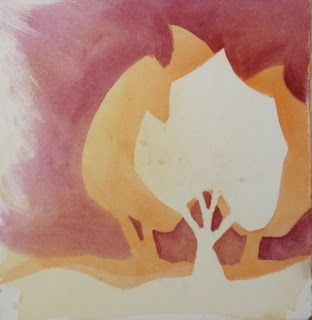Some people have difficulty with "negative painting." Some people, like Canadian artist Linda Kemp, paint entirely 100% in the negative. If you paint a subject, say a flower, directly, putting down yellow petals and an orange center and a green stem, you have just engaged in positive painting. Negative painting involves painting AROUND the subject. Gerald Brommer said he doesn't care for the term "negative painting" and prefers to call it "painting the unoccupied space."
Carrol Wolf said that someone told her that negative painting was like drawing. With drawing, you put a line around the outer edge of something. With negative painting, you put paint around the edge.
Here is a little demo of negative painting:
First, start with an underpainting of colors you like thrown onto wet paper. I used yellows. Let it dry.
Next paint orange all around a tree shape. You can take the orange all the way to the edge of the paper or just let it blend away. It doesn't matter, because most of it is going to get covered up. Let that layer dry. Let the paint dry between layers for hard edges. Painting on top of wet paint makess for soft edges.
Now paint quinacridone violet around two more tree shapes. Note how there now appear to be two orange trees that are behind the pale tree. Also note how parts of the orange trees show through the branch holes of the pale tree.
Next, paint red around some more tree shapes. Note how there now appears to be a row of violet trees behind the orange and light trees.
Now use ultramarine to suggest a row of red trees.
Finally, use an opaque paint, such as jaune brilliant, for the sky, leaving the ultramarine to look like mountains behind the trees. A few dots of jaune brilliant between tree trunks may suggest light shining through some trees way in the back.
"Little Trees"
Here are some of my paintings using Linda Kemp's 100% negative painting method:
"Flame Trees"
"Forest for the Trees"
"Mauve Evening"
And here is a floral painting done entirely by "painting the unoccupied space":
"Winter Whites"




























